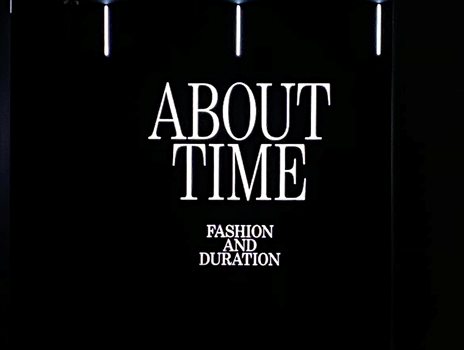About Time: Fashion and Duration
Celebrating The Metropolitan Museum of Art's 150th anniversary, About Time: Fashion and Duration, traces a century and half’s worth of women’s dresses in its examination of fashion’s ephemeral and cyclical evolution from the 1870s to the present.
About Time: Fashion and Durability Exhition Entrance. Photo: © Matilda Liu.
Without the romp and pomp of a star-studded Met Ball red carpet this past May, the Costume Institute’s annual fashion exhibition About Time: Fashion and Duration opened in October 2020 in a more low-key manner. In lieu of theatrical attires and flashing cameras is a solemn, socially distanced queue on the second floor of the Metropolitan Art Museum, where visitors are herded slowly and cautiously along with the rhythmic beeps of a digital thermometer. Less “who are you wearing?!” and more “where is your mask?”.
In two adjacent rooms, 120 dresses are presented in chronological pairs of two with a historical design on the left and a contemporary design on the right, linked together by either their silhouettes, materials, patterns, techniques, or motifs. Stationed along the bowels of the exhibition in equidistance from one another, the 60 pairings tick along the circular display rooms like minutes on a clock. Above head in the background, Nicole Kidman, Meryl Streep, and Julienne Moore read excerpts out loud from Virginia Wolff’s novels Orlando and Mr. Dalloway.
“Fashion is indelibly connected to time. It not only reflects and represents the spirit of the times, but it also changes and develops with the times, serving as an especially sensitive and accurate timepiece,” said Andrew Bolton, the Wendy Yu Curator in Charge of The Costume Institute. Uniformly black and fitted to the T on headless mannequin bodies, the garments strike with an elegant simplicity. The straightforward visual narrative here, not unlike an elementary school compare and contrast diagram, allows for the focus to be fixed on changes in silhouettes across decades and centuries.
At first glance, fashion has come a long way since its days of snatched corsets and comically puffy bustles of the 1885 American Walking Dress. There are several pieces, such as the 1927 Gabrielle Chanel Jersey Dress and the Dior New Look of 1947, whose dramatic departure from their contemporaries excitingly punctuated and defined periods of time in fashion history. As waistlines fastened and loosened, and hemlines rose and fell, the exhibition reflects on the ever-shifting ideas of femininity. Sometimes the change is linear, other times it is cyclical --- no matter what the tendency, fashion, in all of its ephemerality, is presented in the first room as something that requires constant re-invention in order to produce relevant, modern meanings.
View of Dresses in First Room. Photo: © Matilda Liu.
View of Second Room of Exhibition: 1957- Present. Photo: © Matilda Liu.
The exhibition blooms in the second room. Whereas the narrative up to 1957 is composed and chronological, the second swallows the visitor in panoramic halls of mirrors that multiply the idea of time into infinity. This frenetic immersion is reflective of the disintegration of trends since the 1960s. As exemplified by Issey Miyake’s plissé “flying-saucer dress”, Gianni Versace’s 1994 safety-pin dress, and curve-hugging panelled knit by Azzedine Alaïa, post-1957 fashion is a fragmented, highly self-conscious postmodern gag on itself. Rather than aspiring for a unifying shape that can embody the zeitgeist of its era, designers borrowed and played with achronological features as if engaged in a fit of drunken collage. The tone is overwhelming, irreverent, and at times simply humorous.
On the left: Iris Van Herpen Dress 2012, On the right: Charles James Ball Gown 1951. Photo: © The Metropolitan Museum of Art
The beautiful frenzy culminates in patchwork gown from Victor&Rolf’s spring/summer 2020 haute couture collection. Made from leftover fabric scraps, the strapless white dress is suspended celestially amongst a halo of feathers. After 150 years of back and forth, up and down, here to there, the countdown is finally over: it is time we focus on sustainability in fashion!
Viktor & Rolf, Spring/ Summer 2020 haute couture; Headpiece by Shay Ashuai in collaboration with Yevgeny Koramblyum. Photo: © Matilda Liu.
In an industry that is always about chasing the new, About Time shows just how non-linear and repetitive fashion is in reality. In an age of fast fashion and immediate gratification (reminder: this exhibition in its conception did not anticipate a global pandemic that would grind time to a halt), About Time undermines the illusion of new as glamorous by offering up an alternate narrative of timelessness and durability. By becoming more educated about the past, one can emerge from the exhibition becoming more mindful about the present and future.
Andrew Bolton’s strength has always been his ability to communicate extensive scholarly research and complex academic concepts with aesthetic acuity, and this shows in About Time. With no explanatory texts, the task of contextualisation and interpretation of fashion’s relationship with time depends solely on the spectacle of the garments themselves. The selection of heritage designers, such as 19th century American dressmaker Mrs. Reynolds, showed an impressive breadth of archival research into the depth of fashion designs. This is equally matched by the excitingly diverse range of Avant-garde and contemporary designers such as Commes de Garçon and Off-White. Every minute in this clock is filled with a new discovery and many a-ha moments are to be found.
About Time: Fashion and Duration ran from October 29, 2020 to February 7, 2021. If you missed out on seeing the exhibit or want to hear more, follow this YouTube link to join Andrew Bolton on a guided tour of the exhibition.
Matilda Liu
Contributor, MADE IN BED






